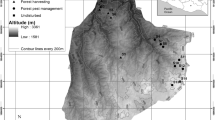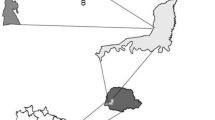Abstract
Examining the regeneration response of species is one of the key ecological analyses vital to understanding and predicting the spatial structure of plant populations and designing specific management plans in the face of anthropogenic and climate change factors. Despite the ecological and traditional importance of Vepris dainellii species, little is known about the effects of anthropogenic disturbances on its natural regeneration patterns and recruitment structure. This study investigates the regeneration and recruitment response of Vepris dainellii and its correlation to disturbance particularly clear-cut in Sirso moist evergreen Afromontane forest, Ethiopia. By employing transect sampling technique, fifty sample plots (20 m × 20 m size) were laid in five transect lines for exploring V. dainellii species in Sirso moist evergreen Afromontane forest. In plots, where V. dainellii were found, vegetation data and stumped individuals (timber pieces resulting from the illegal cutting of trees) were recorded. Regeneration was recorded using sub-plots. Vepris dainellii is the first ranked woody species by recorded a higher number of bowdlerized stems. The regeneration of V. dainellii species was higher in disturbed sites compared to undisturbed sites. Besides, the regeneration of the species positively correlates with the intensity of clear-cuts or the number of stump individuals of the species (73.5%). Whereas, the species regeneration and forest canopy cover, altitude, slope and aspect were not correlated. Vepris dainellii is a disturbance resilient species with the presence of mother trees. Though, this study suggested detailed research on the threshold of clear-cut intensity and functional traits in response to disturbance in moist forest ecosystems.






Similar content being viewed by others
References
Amejo AG (2018) Map** soil terrain resources and descriptions of agro-ecological zone in Dawuro and Gamo Gofa zones in south-western Ethiopia. J Soil Sci Enviro 9:164–179
Awoke H, Mewded B (2019) Changes in woody species composition and structure of Denkoro dry evergreen Afromontane forest over 16 years (2001–2017), South Wollo, Ethiopia. For Ecol Manag 441:71–79
Banihashemi E, Tahmasebi KP, Asadi E (2018) Variation of plant functional groups along livestock grazing gradient in semi-steppe rangelands (case study: tangsayad rangelands of Chaharmahal Bakhtiari Province, Iran). J Rangel Sci 8:52–64
Bekele T, Haase G, Soromessa T, Edward S, Demissie A, Bekele T, Haase G (1999) Forest genetic resources of Ethiopia: status and proposed actions. Institute of Biodiversity Conservation and Research (IBCR), Addis Ababa
Cazzolla Gatti R, Castaldi S, Lindsell JA, Coomes DA, Marchetti M, Maesano M, Di Paola A, Paparella F, Valentini R (2015) The impact of selective logging and clearcutting on forest structure, tree diversity and above-ground biomass of African tropical forests. Ecol Res 30:119–132
Chapagain U, Chapagain BP, Nepal S, Manthey M (2021) Impact of disturbances on species diversity and regeneration of nepalese sal (Shorea robusta) forests managed under different management regimes. Earth 2:826–844
Darrigo MR, Venticinque EM, dos Santos FA (2016) Effects of reduced impact logging on the forest regeneration in the central Amazonia. For Ecol Manag 360:52–59
de Carvalho A, d’Oliveira M, Putz F, de Oliveira L (2017) Natural regeneration of trees in selectively logged forest in western Amazonia. For Ecol Manag 392:36–44
de Winter I, van der Hoek S, Schütt J, Heitkönig IM, Van Hooft P, Gort G, Prins HH, Sterck F (2018) Anthropogenic disturbance effects remain visible in forest structure, but not in lemur abundances. Biol Conserv 225:106–116
Dyderski MK, Jagodziński AM (2018) Low impact of disturbance on ecological success of invasive tree and shrub species in temperate forests. Plant Ecol 219:1369–1380
Friis I, Demissew S, Van Breugel P (2010) Atlas of the potential vegetation of Ethiopia. Det Kongelige Danske Videnskabernes Selskab, Copenhagen
Funk JL, Larson JE, Ames GM, Butterfield BJ, Cavender-Bares J, Firn J, Laughlin DC, Sutton-Grier AE, Williams L, Wright J (2016) Revisiting the Holy Grail: using plant functional traits to understand ecological processes. Biol Rev 92:1156–1173
Gautam MK, Manhas RK, Tripathi AK (2016) Patterns of diversity and regeneration in unmanaged moist deciduous forests in response to disturbance in Shiwalik Himalayas, India. J Asia-Pac Biodivers 9:144–151
Gillison AN (2019) Plant functional indicators of vegetation response to climate change, past present and future: II. Modal plant functional types as response indicators for present and future climates. Flora 254:31–58
Hammond ME, Pokorný R, Okae-Anti D, Gyedu A, Obeng IO (2021) The composition and diversity of natural regeneration of tree species in gaps under different intensities of forest disturbance. J For Res 32:1843–1853
Heilmeier H (2019) Functional traits explaining plant responses to past and future climate changes. Flora 254:1–11
Johnson DJ, Magee L, Pandit K, Bourdon J, Broadbent EN, Glenn K, Kaddoura Y, Machado S, Nieves J, Wilkinson BE, Zambrano AM (2021) Canopy tree density and species influence tree regeneration patterns and woody species diversity in a longleaf pine forest. For Ecol Manag 490:119082. https://doi.org/10.1016/j.foreco.2021.119082
Johnstone JF, Allen CD, Franklin JF, Frelich LE, Harvey BJ, Higuera PE, Mack MC, Meentemeyer RK, Metz MR, Perry GL, Schoennagel T (2016) Changing disturbance regimes, ecological memory, and forest resilience. Front Ecol Environ 14:369–378
Kent M (2012) Vegetation description and data analysis: a practical approach. Wiley, Chichester
Long RL, Gorecki MJ, Renton M, Scott JK, Colville L, Goggin DE, Commander LE, Westcott DA, Cherry H, Finch-Savage WE (2015) The ecophysiology of seed persistence: a mechanistic view of the journey to germination or demise. Biol Rev 90:31–59
Magurran A (2004) Measuring biological diversity. Blackwell, Oxford
Mewded B, Lemessa D (2019) Factors affecting woody carbon stock in Sirso moist evergreen Afromontane forest, southern Ethiopia: implications for climate change mitigation. Environ Dev Sustain 22:6363–6378
Mewded B, Negash M, Awas T (2019) Woody species composition, structure and environmental determinants in a moist evergreen Afromontane forest, southern Ethiopia. J For Res 31:1173–1186
Mueller D, Ellenberg H (1974) Aims and methods of vegetation ecology. Willey, NewYork
Omondi SF, Odee DW, Ongamo GO, Kanya JI, Khasa DP (2017) Effects of anthropogenic disturbances on natural regeneration and population structure of gum arabic tree (Acacia senegal) in the woodlands of Lake Baringo ecosystem, Kenya. J For Res 28:775–785
Poudyal BH, Maraseni T, Cockfield G (2018) Evolutionary dynamics of selective logging in the tropics: A systematic review of impact studies and their effectiveness in sustainable forest management. For Ecol Manag 430:166–175
Rodrigo A, Retana J, Picó FX (2004) Direct regeneration is not the only response of Mediterranean forests to large fires. Ecology 85:716–729
Seidl R, Spies TA, Peterson DL, Stephens SL, Hicke JA (2015) Searching for resilience: addressing the impacts of changing disturbance regimes on forest ecosystem services. J Appl Ecol 53:120–129
Shive KL, Preisler HK, Welch KR, Safford HD, Butz RJ, O’Hara KL, Stephens SL (2018) From the stand scale to the landscape scale: predicting the spatial patterns of forest regeneration after disturbance. Ecol Appl 28(1626):1639
Stevens JT, Safford HD, Harrison S, Latimer AM (2015) Forest disturbance accelerates thermophilization of understory plant communities. J Ecol 103:1253–1263
Swaim JT, Dey DC, Saunders MR, Weigel DR, Thornton CD, Kabrick JM, Jenkins MA (2018) Overstory species response to clearcut harvest across environmental gradients in hardwood forests. For Ecol Manag 428:66–80
Syampungani S, Geldenhuys CJ, Chirwa PW (2016) Regeneration dynamics of miombo woodland in response to different anthropogenic disturbances: forest characterisation for sustainable management. Agrofor Syst 90:563–576
Vasques A, Baudena M, Vallejo VR, Kéfi S, Bautista S, Santana VM, Baeza MJ, Maia P, Keizer JJ, Rietkerk M (2022) Post-fire regeneration traits of understorey shrub species modulate successional responses to high severity fire in mediterranean pine forests. Ecosystems. https://doi.org/10.1007/s10021-022-00750-z
Vasquez-Morales SG, Sánchez-Velásquez LR, del Rosario P-López M, Díaz-Fleischer F, Flores-Estévez N, Viveros-Viveros H (2017) Moderate anthropogenic disturbance does not affect the demography of Magnolia schiedeana, an endangered species from Mexico. Flora 234:77–83
Vivero J, Kelbessa E, Demissew S (2005) The red list of endemic trees & shrubs of Ethiopia and eritrea. Fauna & flora international, Cambridge
Wiehle M, Vornam B, Wesche K, Goenster S, Buerkert A (2016) Population structure and genetic diversity of Populus laurifolia in fragmented riparian gallery forests of the Mongolian Altai Mountains. Flora 224:112–122
Yirdaw E, Starr M, Negash M, Yimer F (2015) Influence of topographic aspect on floristic diversity, structure and tree line of afromontane cloud forests in the Bale Mountains, Ethiopia. J For Res 26:919–931
Zeppel M, Harrison S, Adams H, Kelley D, Li G, Tissue D, Dawson T, Fensham R, Medlyn B, Palmer A, West AG (2015) Drought and re-sprouting plants. New Phytol 206:583–589
Acknowledgements
Our special thanks go to Dr. Tesfaye Awas, senior researcher and project coordinator in Forest and Rangeland Plant Biodiversity Directorate, Ethiopian Biodiversity Institute for his unreserved assistance throughout our work. We are also grateful to Melokoza district administration for their assistance during data collection.
Funding
This work was supported by Ethiopian Biodiversity Institute.
Author information
Authors and Affiliations
Corresponding author
Ethics declarations
Conflict of interest
We declare that we have no conflicts of interest to disclose.
Rights and permissions
Springer Nature or its licensor holds exclusive rights to this article under a publishing agreement with the author(s) or other rightsholder(s); author self-archiving of the accepted manuscript version of this article is solely governed by the terms of such publishing agreement and applicable law.
About this article
Cite this article
Mewded, B., Erbo, K. Regeneration response of Vepris dainellii, an endemic species of Ethiopia to disturbance in moist forest ecosystem. Trop Ecol 64, 511–518 (2023). https://doi.org/10.1007/s42965-022-00273-7
Received:
Revised:
Accepted:
Published:
Issue Date:
DOI: https://doi.org/10.1007/s42965-022-00273-7




